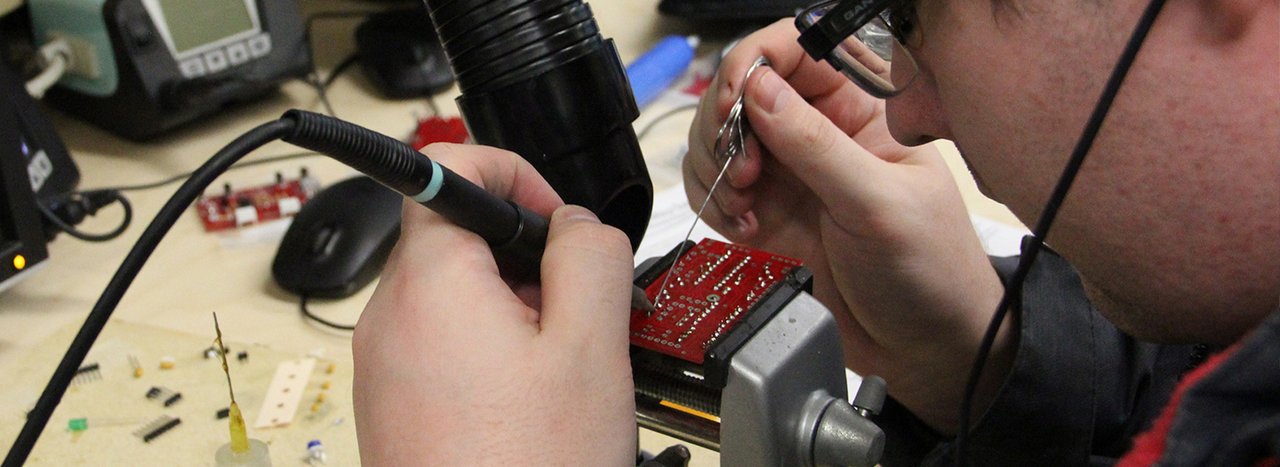


By: Xuhua Huang, Liam O’Brien, Nasr Kharrat
The Dual Mode Robot is a remote-control car that can drive forwards, backwards, left and right. The user controls the robot via a Graphical User Interface on Windows. Using this software, the speed and turning radius can be controlled by the user, along with an emergency stop feature included and a feature that enables the vehicle to automatically avoid obstacles using sensors to prevent the vehicle from taking any damage from collisions.

By: Ryan Laxdal- Diego Montpetit – Gary Coffin
The electric fun car is a 4 wheel drive electric car built for children. What sets this car aside from other children’s vehicles is that the steering wheel and gas pedal are replaced by a GUI (Graphical User Interface)! To operate the vehicle, the user chooses inputs on the GUI, the GUI sends the information wirelessly to a microcontroller. The microcontroller interprets these signals using C++ language and passes the interpreted signals to our H-Bridge controller. Then the H-Bridges allow current to flow from the 12V to the motors as requested by the user.

By: Kaiyu Sakamoto-David
Smart Coffee is a Wi-Fi controlled coffee maker. Users can turn on and off the coffee machine from the Smart Coffee app. The app also allows users to set up a timer so that Smart Coffee can start brewing at a desired time. Furthermore, it notifies the user if the tank is low on water.

By: Gabriel Mantha, John Bohemier and Alex Apsley
Our project is similar to an aircraft flight recorder, better known as a black box. The goal of our project is to track various data from flights performed with a hobbyist drone and send it off to our GUI displayed on a laptop in real time. Our product lies underneath the drone in an enclosure, not affecting its flying capabilities. Our GUI uses a customized 3D model to display the orientation of the drone. Our Blackbox also uses a GPS module to allow us to track the location of the drone. Other features include tracking of battery life and displaying live video.

By: Christopher Becher
A Switcher is an Arduino-based Internet-Of-Things device that controls a household light switch with a little servo motor. I used Embarcadero’s C++ Builder to build an Android application, which communicates with the Switcher using WiFi. It allows the user to toggle the light switch in real-time or in the future, and updates when the light is switched manually. The Switcher is lithium-ion battery powered and rechargeable.


By: Alexei Jolicoeur-McCharles
The AutoBar is an automated bartender device that takes drink orders wirelessly via an android application and lets the user dispense their own amount of liquors/mixers via manual buttons. Using air pumps and a 6-relay system connected to an Arduino microcontroller, this device can prepare six different types of drinks in three different sizes. It is also equipped with a cleaning function to clean its tubing.


By: Thomas Skene
The MIDI-Verter is the musician’s Swiss army knife. It hooks up to any analog synthesizer and turns it into a MIDI-ready instrument!

By: Nathan Bourassa
The Graphic equalizer is a device that can play a song and represent it visually. Through LED’s the wave of the audio signal is represented graphically. A graphical user interface can be used to control the color of the lights as well as play and change songs in the same fashion to an MP3 player. Finally new songs can be added manually in a similar manner to an MP3 player.

By: Jean-Roland Dupuy
This Third-year project is a remote-controlled vehicle which also could be a Sumo bot. The design of the vehicle is to look like a sumo bot. There are two modes of operation for this product: the main mode is to control the vehicle remotely and the autonomous mode for sumo bot functionality. In both modes, a wireless connection to WIFI is required and a computer to operate/monitor the product.

By: John Evans
The SynthBox is an Arduino based music project The SynthBox takes human input from virtual piano keys, and physical potentiometers, to allow the user to create and alter different sounds. The sound aspect of the project is based around a DSP-G1 analog modeling IC, which is used to create beautiful MIDI sounds, reminiscent of video games from the 80’s and 90’s.

By: Benoit Moreau
The goal of this project was to build an unmanned ground vehicle (UGV) with a turret that shoots foam darts This UGV can move forwards, backwards, left and right as well as shoot things. All of these actions can be controlled remotely by a user via a graphical user interface on a computer. Using this interface, the user can move the vehicle using the WASD keys and fire the gun using the left mouse button. The connection between the vehicle and the interface is done using WIFI.

By: Giresse Wambo
This project will help computer lab teachers to manage their in-class questions by the students. The program will run a code that will prioritize position of students. An LED and a Liquid Crystal Display (LCD) will be use in order to show the position of the students. The Microcontroller will acknowledge the student button pressed, then it will transfer the code information to the Graphical User Interface (GUI) via Wi-Fi connection. The GUI will get the code information, apply the code and confirm reception to the microcontroller via the same Wi-Fi connection.

By: Owen Jakob
This project consists of a device designed to record information about a model rocket’s flight. The data recorder fits inside the airframe of a rocket and utilizes various sensors to determine altitude, orientation, acceleration and other characteristics about the flight. The data is simultaneously transmitted back to the ground for live viewing and recording on a ground-control application.